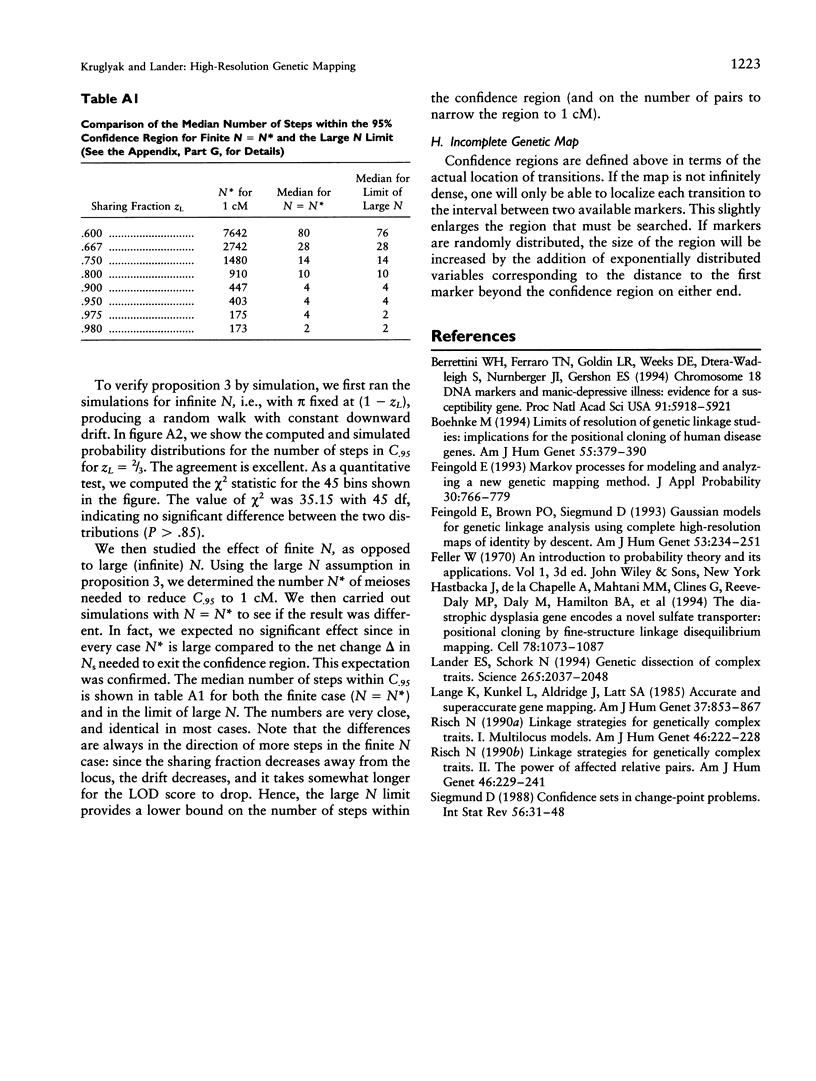Abstract
Positional cloning requires high-resolution genetic mapping. To plan a positional cloning project, one needs to know how many informative meioses will be required to narrow the search for a disease gene to an acceptably small region. For a simple Mendelian trait studied with linkage analysis, the answer is straightforward. In this paper, we address the situation of a complex trait studied with affected-relative-pair methods. We derive mathematical formulas for the size of an appropriate confidence region, as a function of the relative risk attributable to the gene. Using these results, we provide graphs showing the number of relative pairs required to narrow the gene hunt to an interval of a given size. For example, we show that localizing a gene to 1 cM requires a median of 200 sib pairs for a locus causing a fivefold increased risk to an offspring and 700 sib pairs for a locus causing a twofold increased risk. We discuss the implications of these results for the positional cloning of genes underlying complex traits.
Full text
PDF











Selected References
These references are in PubMed. This may not be the complete list of references from this article.
- Berrettini W. H., Ferraro T. N., Goldin L. R., Weeks D. E., Detera-Wadleigh S., Nurnberger J. I., Jr, Gershon E. S. Chromosome 18 DNA markers and manic-depressive illness: evidence for a susceptibility gene. Proc Natl Acad Sci U S A. 1994 Jun 21;91(13):5918–5921. doi: 10.1073/pnas.91.13.5918. [DOI] [PMC free article] [PubMed] [Google Scholar]
- Boehnke M. Limits of resolution of genetic linkage studies: implications for the positional cloning of human disease genes. Am J Hum Genet. 1994 Aug;55(2):379–390. [PMC free article] [PubMed] [Google Scholar]
- Feingold E., Brown P. O., Siegmund D. Gaussian models for genetic linkage analysis using complete high-resolution maps of identity by descent. Am J Hum Genet. 1993 Jul;53(1):234–251. [PMC free article] [PubMed] [Google Scholar]
- Hästbacka J., de la Chapelle A., Mahtani M. M., Clines G., Reeve-Daly M. P., Daly M., Hamilton B. A., Kusumi K., Trivedi B., Weaver A. The diastrophic dysplasia gene encodes a novel sulfate transporter: positional cloning by fine-structure linkage disequilibrium mapping. Cell. 1994 Sep 23;78(6):1073–1087. doi: 10.1016/0092-8674(94)90281-x. [DOI] [PubMed] [Google Scholar]
- Lander E. S., Schork N. J. Genetic dissection of complex traits. Science. 1994 Sep 30;265(5181):2037–2048. doi: 10.1126/science.8091226. [DOI] [PubMed] [Google Scholar]
- Lange K., Kunkel L., Aldridge J., Latt S. A. Accurate and superaccurate gene mapping. Am J Hum Genet. 1985 Sep;37(5):853–867. [PMC free article] [PubMed] [Google Scholar]
- Risch N. Linkage strategies for genetically complex traits. I. Multilocus models. Am J Hum Genet. 1990 Feb;46(2):222–228. [PMC free article] [PubMed] [Google Scholar]
- Risch N. Linkage strategies for genetically complex traits. II. The power of affected relative pairs. Am J Hum Genet. 1990 Feb;46(2):229–241. [PMC free article] [PubMed] [Google Scholar]


